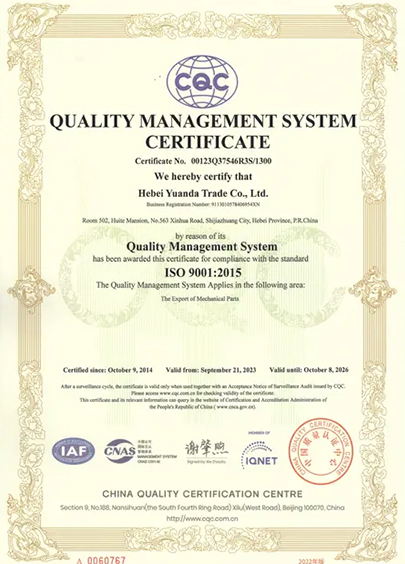Mobile:+86-311-808-126-83
Email:info@ydcastings.com
pump body casting
The Importance of Pump Body Casting in Industrial Applications
Pump body casting plays a pivotal role in numerous industrial applications, providing the essential framework that supports the various components of pumps. As integral parts of various systems—ranging from water supply and sewage treatment to chemical processing—pump bodies are crucial for ensuring the efficient operation of pumps. This article delves into the intricacies of pump body casting, highlighting its significance, processes, and advancements in technology.
Understanding Pump Body Casting
Casting is a manufacturing process where a liquid material is poured into a mold to create a specific shape upon solidification. In the context of pump bodies, casting is typically performed using metals such as cast iron, aluminum, or stainless steel, chosen for their excellent durability, corrosion resistance, and ability to withstand high pressures.
The pump body, also known as the pump housing, encloses and protects internal components such as impellers and shafts, while also directing the flow of liquids. A well-designed pump body ensures a smooth flow path, minimizing turbulence and enhancing the efficiency of fluid transport. Therefore, the casting process must be meticulously engineered to adhere to precise specifications and tolerances.
The Casting Process
The casting process for pump bodies involves several key steps
1. Pattern Making This initial phase involves creating a replica of the pump body, known as a pattern. Patterns can be made from various materials including wood, metal, or plastic, depending on the required precision and volume of production.
2. Mold Creation The pattern is then used to create molds. These molds are designed to accommodate the flow of molten metal and may be permanent or disposable. The choice of mold type affects the casting method employed and the final characteristics of the pump body.
3. Melting and Pouring The chosen metal is melted in a furnace. Once it reaches the appropriate temperature, it is poured into the mold. The method of pouring, whether gravity, pressure, or vacuum, can significantly influence the quality of the casting.
4. Cooling and Solidification After pouring, the molten metal must cool and solidify within the mold, forming the pump body. The cooling rate can affect the microstructure of the metal, influencing the mechanical properties of the finished product.
5. Finishing Operations Once solidified, the cast pump body is removed from the mold and subjected to finishing processes such as machining, cleaning, and surface treatment. These operations ensure that each component meets stringent quality standards.
pump body casting

Advantages of Pump Body Casting
Casting technology offers several advantages over other manufacturing methods for pump bodies
- Complex Shapes Casting allows for the production of complex geometries that might be difficult or costly to achieve through machining alone, enabling innovative designs tailored to specific applications.
- Material Efficiency The casting process can minimize waste by utilizing molten metal efficiently, leading to lower material costs.
- Large-Scale Production Once patterns and molds are created, casting is highly scalable, allowing for mass production of pump bodies without significant increases in cost.
- Enhanced Performance Modern casting techniques allow for the incorporation of features that enhance the performance and longevity of the pump body, such as improved cooling channels and reinforced structural components.
Innovations in Pump Body Casting
With the advent of new technologies, the field of pump body casting is witnessing significant advancements. The use of computer-aided design (CAD) and computer-aided manufacturing (CAM) has improved the precision of pattern making and mold creation. Additionally, the development of additive manufacturing techniques, including 3D printing, is revolutionizing how patterns are produced, reducing lead times and costs.
Moreover, advancements in materials science have led to the use of advanced alloys with enhanced properties, leading to lighter yet stronger pump bodies that can withstand harsher operating environments. Integrated smart technologies are also being explored, enabling real-time monitoring of pump performance and predicting maintenance needs.
Conclusion
In conclusion, pump body casting is an essential manufacturing process that underpins the functionality and performance of pumps across various industries. With its ability to produce complex shapes efficiently and affordably, along with ongoing innovations in materials and technology, casting will continue to play a vital role in the future of industrial applications. As industries evolve and demands increase, the importance of high-quality, durable pump bodies will remain a cornerstone of effective fluid management solutions.
-
Why Should You Invest in Superior Pump Castings for Your Equipment?NewsJun.09,2025
-
Unlock Performance Potential with Stainless Impellers and Aluminum End CapsNewsJun.09,2025
-
Revolutionize Your Machinery with Superior Cast Iron and Aluminum ComponentsNewsJun.09,2025
-
Revolutionize Fluid Dynamics with Premium Pump ComponentsNewsJun.09,2025
-
Optimizing Industrial Systems with Essential Valve ComponentsNewsJun.09,2025
-
Elevate Grid Efficiency with High-Precision Power CastingsNewsJun.09,2025











